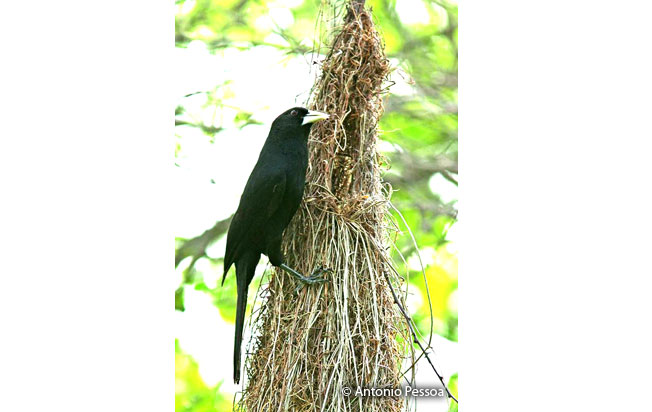Order: Passeriformes | Family: Icteridae | IUCN Status: Least Concern

Age: Adult | Sex: Unknown | Loc. Amazonia, Brazil

Age: Adult | Sex: Unknown | Loc. Amazonia, Brazil

Age: Adult | Sex: Unknown | Loc. Amazonia, Brazil

Age: Adult | Sex: Unknown | Loc. Amazonia, Brazil
Identification & Behavior: ~27 cm (10.6 cm). The Solitary Black Cacique is solid black. The iris is brown. The bill is pale yellowish. The tail is roundish. It forages in dense understory in pairs or alone. The Solitary Black Cacique is similar to the rare and range-restricted (in Peru) Ecuadorian Cacique but has a noticeably brown iris and forages in dense understory. It is also similar to a Velvet-fronted Grackle, which forages in the forest mid-story and has a black bill.
Status: The Solitary Black Cacique is uncommon and widespread in Amazonia where it is known to range up to 1300 m along the foothill of the Andes. It also occurs in Co, Ec, Br, and Bo.
Name in Spanish: Cacique Solitario.
Sub-species: Solitary Black Cacique (Cacicus solitarius), Vieillot, 1816.
Meaning of Name: Cacicus: Spanish Caique= Indian Chief. solitarius: L. solus, solius= alone, solitaries= solitary.
Distribution Map
 Voice
Voice
 Voice
VoiceReferences:
-
- Species range based on: Schulenberg, T. S., D. F. Stotz, and L. Rico. 2006. Distribution maps of the birds of Peru, version 1.0. Environment, Culture & Conservation (ECCo). The Field Museum. http://fm2.fieldmuseum.org/uw_test/birdsofperu on 03/01/2016.